This Special Release presents data on men and women for National Capital Region IV- CAMANAVA. Figures are based from the results of the 2015 Census of Population (POPCEN 2015).
Sex Ratio is at 101 Men per 100 Women
The results of the 2015 Census of Population (POPCEN 2015) showed that the total population of NCR IV reached 2,819,388 with 50.3 percent men (1,417,163) and 49.7 percent women (1,402,225). These data resulted to a sex ratio of 101 which means that there were 101 males per 100 females. Sex ratio recorded in 2010 was 100.
Table 1. Household Population by Age Group and Sex: National Capital Region IV, 2015
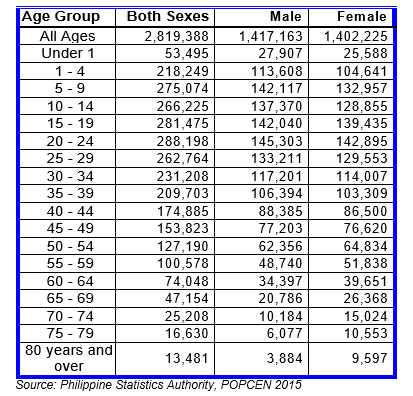
In 2015, the median age of the population of NCR IV 25.4 years, which means that half of the population of the province was younger than 25.4 years. This was slightly higher than the median age of 24.5 years that was recorded in 2010. Moreover, 28.8 percent of the total population was under 15 years old. Persons 20 to 24 years (10.2 percent) comprised the largest age group, followed by those in the age groups 15 to 19 (10.0 percent), 5 to 9 years (9.8 percent), 0 to 4years (9.6 percent), and 10 to 14 years (9.4 percent). Males outnumbered females in the age groups 0 to 49 years. On the other hand, there were more females than males in the older age groups (50 years and over).
More Males than Females in CAMANAVA
Among the cities, Valenzuela registered the highest population of women at 49.92 percent of the city’s total population. On the other hand, Malabon registered the lowest population of women at 49.23 percent compared to men with 50.77 percent.
Figure 1. Total Population by Sex and by City: National Capital Region- IV (CAMANAVA), 2015
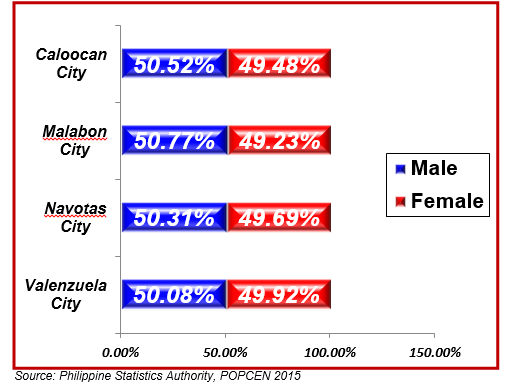
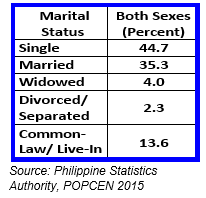 More Males than Females in Voting Age
Household population 18 years old and over (voting age) in NCR IV was at 1,839,625 which comprises 65.25 percent of the total. From this, men (50.5 percent) are slightly higher than women with 49.5 percent.
More Male Dependents than Female per Working Age Population
In 2015, there are 813,043 young dependents (0-14 years old) and 102,473 old dependents (65 years old and over). Working age population (15-64 years) is at 1,903,872.
From this, the overall dependency ratio of the province is 48.09 percent. This means that there were about 48 dependents per 100 persons of working age. Of the total number of dependents, 50.45 percent were males while 49.55 percent were females.
More Females had Attained Higher Levels of Education than Men
Out of the 2.55 million total population aged five years and over,
22.6 percent had attended or completed elementary education, 43.0 percent had reached or finished high school, 14.2 percent was college undergraduate, and 13.9 percent was baccalaureate/ college graduate. Among those with a baccalaureate/ college degree, the females (55.0 percent) outnumbered the males (45.0 percent). Similarly, more females (59.3 percent) than males (40.7 percent) had pursued post baccalaureate courses.
More Males than Females among Single Persons
Of the 2.27 million total populations aged 10 years and over, 44.7 percent was single while 35.3 percent was married. The rest of the total population was categorized as follows: in common-law/ live-in marital arrangement (13.6 percent), widowed (4.0 percent), and divorced/ separated (2.3 percent).
Figure 2. Total Population 10 years and over by Sex and by Marital Status:NCR IV (CAMANAVA), 2015
More Males than Females in Voting Age
Household population 18 years old and over (voting age) in NCR IV was at 1,839,625 which comprises 65.25 percent of the total. From this, men (50.5 percent) are slightly higher than women with 49.5 percent.
More Male Dependents than Female per Working Age Population
In 2015, there are 813,043 young dependents (0-14 years old) and 102,473 old dependents (65 years old and over). Working age population (15-64 years) is at 1,903,872.
From this, the overall dependency ratio of the province is 48.09 percent. This means that there were about 48 dependents per 100 persons of working age. Of the total number of dependents, 50.45 percent were males while 49.55 percent were females.
More Females had Attained Higher Levels of Education than Men
Out of the 2.55 million total population aged five years and over,
22.6 percent had attended or completed elementary education, 43.0 percent had reached or finished high school, 14.2 percent was college undergraduate, and 13.9 percent was baccalaureate/ college graduate. Among those with a baccalaureate/ college degree, the females (55.0 percent) outnumbered the males (45.0 percent). Similarly, more females (59.3 percent) than males (40.7 percent) had pursued post baccalaureate courses.
More Males than Females among Single Persons
Of the 2.27 million total populations aged 10 years and over, 44.7 percent was single while 35.3 percent was married. The rest of the total population was categorized as follows: in common-law/ live-in marital arrangement (13.6 percent), widowed (4.0 percent), and divorced/ separated (2.3 percent).
Figure 2. Total Population 10 years and over by Sex and by Marital Status:NCR IV (CAMANAVA), 2015
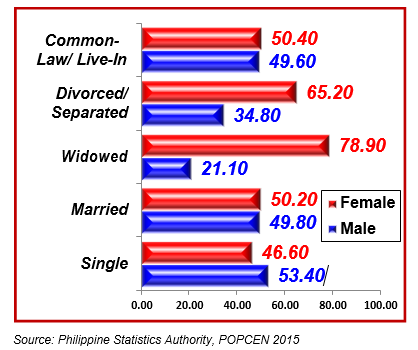 Among the single persons, 53.4 percent was male, while 46.6 percent was female. In contrast, females outnumbered males in the rest of the categories for marital status.
Table 2. Total Population 10 years and over by Marital Status:
National Capital Region IV (CAMANAVA), 2015
Among the single persons, 53.4 percent was male, while 46.6 percent was female. In contrast, females outnumbered males in the rest of the categories for marital status.
Table 2. Total Population 10 years and over by Marital Status:
National Capital Region IV (CAMANAVA), 2015
 More Males Attended School in 2015
Out of the 1.11 million household population aged 5 to 24 years, 68.1 percent was attending school in School Year (SY) 2015- 2016.
By sex, the school attendance rate in 2015 was slightly higher among males (68.4 percent) than among females (67.8 percent).
Table 3. Household Population 5 to 24 Years Old who were attending School by Sex:
National Capital Region IV (CAMANAVA), 2015
More Males Attended School in 2015
Out of the 1.11 million household population aged 5 to 24 years, 68.1 percent was attending school in School Year (SY) 2015- 2016.
By sex, the school attendance rate in 2015 was slightly higher among males (68.4 percent) than among females (67.8 percent).
Table 3. Household Population 5 to 24 Years Old who were attending School by Sex:
National Capital Region IV (CAMANAVA), 2015
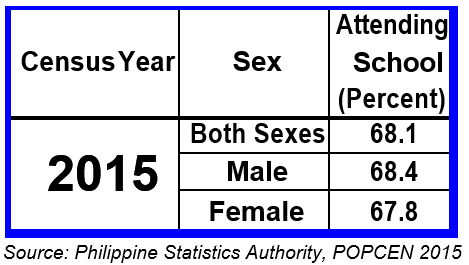 More Senior Citizens Women than Men
Senior Citizens are persons aged 60 years old and over and they made up 6.27% of the total household population of the province. Of the total household population of senior citizens, women (57.3%) outnumbered their men (42.7%) counterpart.
Figure 3. Overseas Workers 15 Years Old and Over by Sex:
NCR IV, 2015
More Senior Citizens Women than Men
Senior Citizens are persons aged 60 years old and over and they made up 6.27% of the total household population of the province. Of the total household population of senior citizens, women (57.3%) outnumbered their men (42.7%) counterpart.
Figure 3. Overseas Workers 15 Years Old and Over by Sex:
NCR IV, 2015
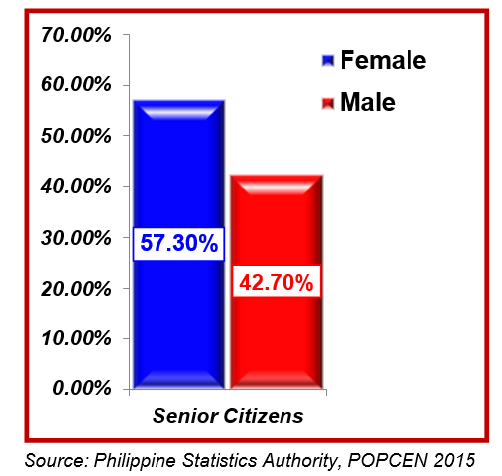 Literacy Rate was Equal among Men and Women at 99.8 Percent
According to the 2015 Census of Population (POPCEN), there were 2,267,060 persons aged 10 years and over in NCR IV. Among the population 10 years old and over, 2,262,968 persons or 99.8 percent were literate. In comparison with the 2010 CPH, the literacy rate was recorded at 99.6 percent. In the 2010 CPH and 2015 POPCEN, a person is considered literate if he/she is able to read and write a simple message in any language or dialect.
Table 4. Literacy Rate of the Household Population 10 Years Old and over by Sex:
National Capital Region IV (CAMANAVA), 2015
Literacy Rate was Equal among Men and Women at 99.8 Percent
According to the 2015 Census of Population (POPCEN), there were 2,267,060 persons aged 10 years and over in NCR IV. Among the population 10 years old and over, 2,262,968 persons or 99.8 percent were literate. In comparison with the 2010 CPH, the literacy rate was recorded at 99.6 percent. In the 2010 CPH and 2015 POPCEN, a person is considered literate if he/she is able to read and write a simple message in any language or dialect.
Table 4. Literacy Rate of the Household Population 10 Years Old and over by Sex:
National Capital Region IV (CAMANAVA), 2015
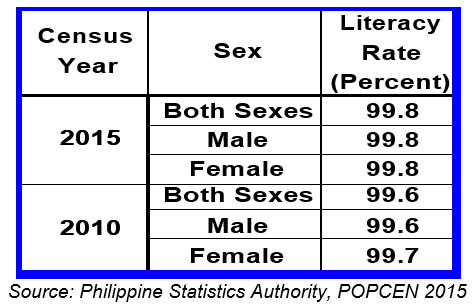 The literacy rate was equal among males and among females aged 10 years and over in 2015 with 99.8 percent each.
Male Overseas Workers outnumbered their Female counterpart
Out of the 2.00 million household population 15 years old and over, 65,583 persons or 3.3 percent were overseas workers. Male overseas workers outnumbered their female counterparts as they comprised 58.4 percent of all the overseas workers from this province. Overseas workers aged 45 and over made up the largest age group, comprising 28.0 percent of the total overseas workers, followed by those in the groups 35 to 39 years (18.0 percent), 30 to 34 years (17.7 percent), and 40 to 44 years (14.7 percent).
Figure 4. Overseas Workers 15 Years Old and Over by Sex: NCR IV, 2015
The literacy rate was equal among males and among females aged 10 years and over in 2015 with 99.8 percent each.
Male Overseas Workers outnumbered their Female counterpart
Out of the 2.00 million household population 15 years old and over, 65,583 persons or 3.3 percent were overseas workers. Male overseas workers outnumbered their female counterparts as they comprised 58.4 percent of all the overseas workers from this province. Overseas workers aged 45 and over made up the largest age group, comprising 28.0 percent of the total overseas workers, followed by those in the groups 35 to 39 years (18.0 percent), 30 to 34 years (17.7 percent), and 40 to 44 years (14.7 percent).
Figure 4. Overseas Workers 15 Years Old and Over by Sex: NCR IV, 2015
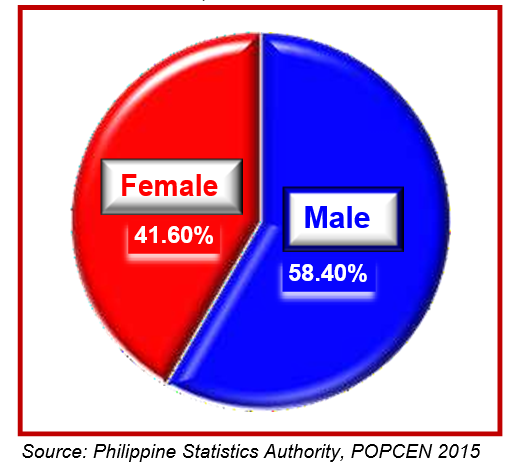 Most Households Were Headed by Men
Of the 668,014 number of households in NCR IV in 2015, Only 22.62 percent were headed by women that accounts to only 151,103 women household heads, while the remaining 77.38 percent were headed by men that accounts to 516,911 household heads. By age group, men were largest in the group 30 to 39 years old while women were largest in the group 50 to 59 years old.
Table 5. Number of Households by Age- Group and Sex of Household Head:
National Capital Region, IV- CAMANAVA, 2015
Most Households Were Headed by Men
Of the 668,014 number of households in NCR IV in 2015, Only 22.62 percent were headed by women that accounts to only 151,103 women household heads, while the remaining 77.38 percent were headed by men that accounts to 516,911 household heads. By age group, men were largest in the group 30 to 39 years old while women were largest in the group 50 to 59 years old.
Table 5. Number of Households by Age- Group and Sex of Household Head:
National Capital Region, IV- CAMANAVA, 2015
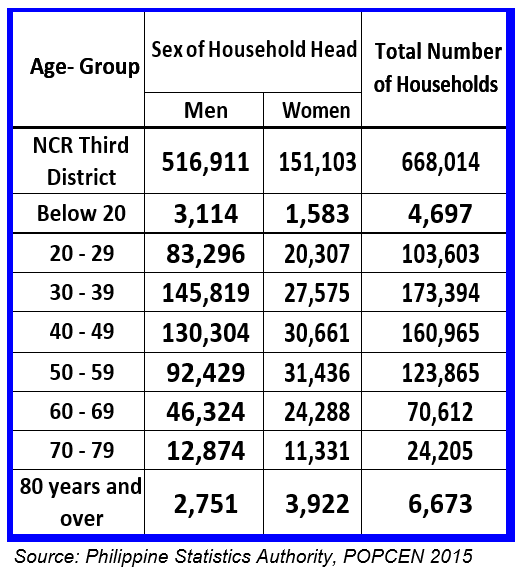 TECHNICAL NOTES
The 2015 Census of Population (POPCEN 2015) was undertaken by the Philippine Statistics Authority (PSA) in August 2015 as mandated by Republic Act No. 10625, otherwise known as the Philippine Statistics Act of 2013. It was the 14th Census of Population that was undertaken since the first census in 1903. POPCEN 2015 was designed to take an inventory of the total population all over the Philippines and collect information about their characteristics. POPCEN 2015 made use of the de jure concept of enumeration wherein households and persons are enumerated in the area where they usually reside as of the census reference date.
Total population
The sum of the household population and institutional population. It also includes Filipinos in Philippine embassies, consulates, and missions abroad
Household population
Comprises of persons who belong to a household, the basic criterion of which is the usual place of residence or the place where the person usually resides
Household
A social unit consisting of a person living alone or a group of persons who sleep in the same housing unit and have a common arrangement in the preparation and consumption of food
Marital status
The personal status of each individual with reference to the marriage laws or customs of the country
Sex ratio
The ratio of males to females in a given population, expressed as the number of males per 100 females
Age
The interval of time between a person’s date of birth and the census reference date (1 August 2015). Expressed in completed years (as of last birthday), it is recorded in whole number
School Attendance Rate
The proportion of persons 5 to 24 years old who were attending school during the School Year June 2015 to March 2016 to school-age population (5 to 24 years old)
Overall dependency ratio
The ratio of persons in the dependent ages (under 15 years old and over 64 years old) to persons in the economically active or working ages (15 to 64 years old) in the population
Simple Literacy Rate
The proportion of persons aged 10 years and over who are able to read and write a simple message in any language or dialect
Head of the Household
An adult person, male or female, who is responsible for the organization and care of the household, or who is regarded as such by the members of the household
Highest Grade
The highest grade or year completed in school, college or university
Overseas Workers
A household member (15 years old and over) who is out of the country due to an overseas employment
BELEN R. RAZO
Chief Statistical Specialist
PSA NCR IV- (CAMANAVA)
TECHNICAL NOTES
The 2015 Census of Population (POPCEN 2015) was undertaken by the Philippine Statistics Authority (PSA) in August 2015 as mandated by Republic Act No. 10625, otherwise known as the Philippine Statistics Act of 2013. It was the 14th Census of Population that was undertaken since the first census in 1903. POPCEN 2015 was designed to take an inventory of the total population all over the Philippines and collect information about their characteristics. POPCEN 2015 made use of the de jure concept of enumeration wherein households and persons are enumerated in the area where they usually reside as of the census reference date.
Total population
The sum of the household population and institutional population. It also includes Filipinos in Philippine embassies, consulates, and missions abroad
Household population
Comprises of persons who belong to a household, the basic criterion of which is the usual place of residence or the place where the person usually resides
Household
A social unit consisting of a person living alone or a group of persons who sleep in the same housing unit and have a common arrangement in the preparation and consumption of food
Marital status
The personal status of each individual with reference to the marriage laws or customs of the country
Sex ratio
The ratio of males to females in a given population, expressed as the number of males per 100 females
Age
The interval of time between a person’s date of birth and the census reference date (1 August 2015). Expressed in completed years (as of last birthday), it is recorded in whole number
School Attendance Rate
The proportion of persons 5 to 24 years old who were attending school during the School Year June 2015 to March 2016 to school-age population (5 to 24 years old)
Overall dependency ratio
The ratio of persons in the dependent ages (under 15 years old and over 64 years old) to persons in the economically active or working ages (15 to 64 years old) in the population
Simple Literacy Rate
The proportion of persons aged 10 years and over who are able to read and write a simple message in any language or dialect
Head of the Household
An adult person, male or female, who is responsible for the organization and care of the household, or who is regarded as such by the members of the household
Highest Grade
The highest grade or year completed in school, college or university
Overseas Workers
A household member (15 years old and over) who is out of the country due to an overseas employment
BELEN R. RAZO
Chief Statistical Specialist
PSA NCR IV- (CAMANAVA)

